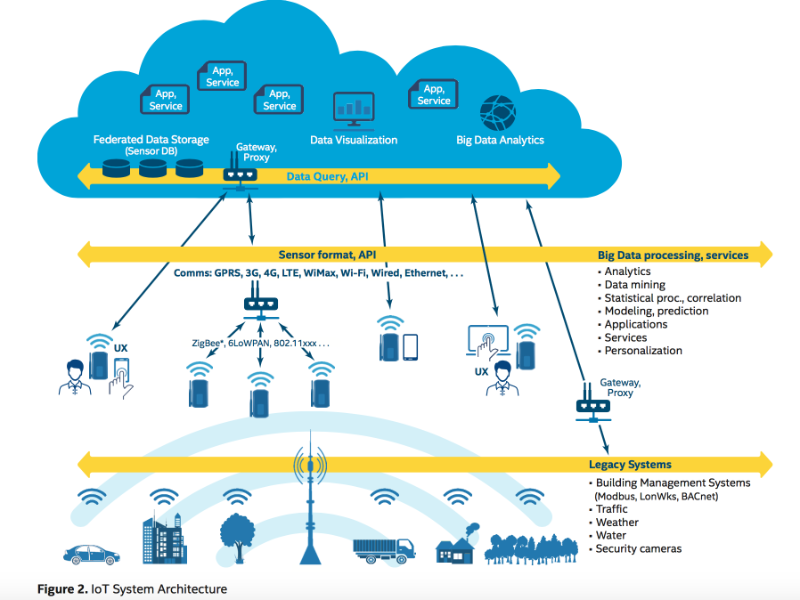Application of blockchain in IoT security
In 2019, although the world is witnessing the decline of the virtual currency bitcoin, no one can deny the technology behind crypto-currency: blockchain. The blockchain model shows remarkable advantages in many different industries and fields. This article will analyze the application of blockchain in Internet-of-Things (IoT) security.

How does blockchain work?
Blockchain is made of 2 words: block (block) and chain (chain link). It is understandable that blockchains are blocks of data linked together. These data blocks are written and verified by each participant participating in the blockchain. Therefore, the more participants participate, the stronger the blockchain system, the higher the security.
Take for example the bitcoin virtual currency (the first unit to use blockchain): every time a bitcoin transaction occurs, all entities in the system will verify that transaction, then contribute data. collected data (details of transaction date and time, amount of money traded, etc.) into a block. This process is called "mining coins" because the NPH has a mechanism to reward bitcoins for participants to verify transactions.
In this way, every transaction is verified and stored by hundreds of thousands of different computers around the world. This makes it difficult for hackers to attack and interfere, modify data.
Challenging IoT security
According to a report by Juniper Research, up to 46 billion internet-connected devices (IoT devices) are expected to be connected by 2021. Meanwhile, the cumulative cost of data breaches from the year 2017 to 2022 is expected to reach $ 8 trillion. Under the pressure of cyber criminals, IoT security will be a major challenge for any enterprise issuing and using IoT devices.
From smart homes and offices to connected cars, drones, self-driving vans and even critical infrastructure like industrial control systems. This system is part of the Industrial Internet (IIoT). All existing and new IoT networks face a very high threat to the network.
Application of blockchain in IoT security
Blockchain technology is an emerging technology along with IoT that will bring many promises in helping devices be connected safely. While Blockchain technology has become prominent in the fintech world (financial technology) by opening an electronic payment revolution, this basic technology platform is the factor behind success and rise of cryptocurrencies. It can play an important role in network security, especially in the IoT space.
Blockchain-based network security platform can secure connected devices by using digital signatures to identify and authenticate these devices. Devices will then act as authorized participants in the blockchain network. Every device that is authenticated to a blockchain-based secure IoT network will be considered a participating entity, just like in a regular blockchain network. All communications between verified participants (IoT devices) will be secured with a password and stored in an anti-forgery log.
Every new device added to the network is registered by assigning a unique digital ID on the Blockchain system. The platform will provide secure channels for communication between devices and at the same time all connected devices will have secure access to the host system or infrastructure. Blockchain-based network security solutions can also take advantage of the Software-defined perimeter (SDP) architecture and use the Zero-Trust model to make all devices that have been authenticated invisible to the attacker. . This means that only verified devices can "see" or know about the existence of other connected devices and thus create an additional layer of security for the IoT infrastructure.
Benefits and the way forward
A blockchain-powered platform uses a decentralized setup, making it nearly impossible for hackers to attack the system by defeating a target.
Consensus-based control distributing security responsibilities on nodes in the blockchain network makes it impossible for hackers to forge into that network and also protects the IoT network from being destroyed by DDoS attacks. Decentralization also makes such a solution more scalable. It is one of the biggest concerns of deploying network security systems on an ever-growing network as in the case of connected devices. With every new device added or deleted, changes will be immediately notified to all participants. This will allow the system to adapt and be flexible to expand and evolve over time without upgrading the entire platform.
Such a system can be used to ensure smart homes, self-driving vehicles are connected, IIoT infrastructure and even a smart city. The network security solution based on blockchain technology enhanced by SDP architecture can provide the next generation with a way of securing IoT devices, networks and communications. This solution not only helps protect businesses against current vulnerabilities and network risks, but is also effective in predicting new vulnerabilities.
Both blockchain and IoT are emerging technologies with most innovations in the field at an early stage. However, combining the strengths of blockchain technology with the potential of IoT can quickly and effectively push entire industries, cities and countries into the "smart" space by reducing The growing burden of protecting the perimeter of infrastructure and other conventional equipment without hindering the pace of innovation.
Operate and exploit advertising by iCOMM Vietnam Media and Technology Joint Stock Company.
Adress: 99 Nguyen Tat Thanh, To 2, Khu 6, Thi tran Tan Phu, Tan Phu, Dong Nai.
Email: [email protected] | Tel: (+84) 984654960
Editor in chief: Tran Nha Phuong
Company: Lucie Guillot (Nha Phuong Tran)




